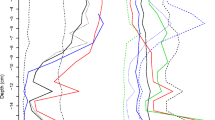Abstract
Polychaetes belonging to the genus Capitella are often present in high numbers in organic-rich sediments polluted with, e.g., oil components, and Capitella spp. may have a great impact on the biogeochemistry of these sediments. We examined the influence of Capitella sp. I on microbial activity in an organic-rich marine sediment contaminated with the polycyclic aromatic hydrocarbon, fluoranthene. Capitella sp. I were added to microcosms (10 000 ind m−2) and the impact of a pulse-sedimentation of fluoranthene-contaminated sediment (3 mm layer) was studied for a period of 12 d after sedimentation. The sediment oxygen uptake and total sediment metabolism (TCO2 production) increased in cores with worms (71 to 131%), whereas the anaerobic activity, measured as sulfate reduction rate 12 d after sedimentation, was lower compared to cores without worms. The effect of fluoranthene on sulfate reduction was most pronounced in the presence of worms, with a 34% reduction versus 16% in cores without worms. The reduced sulfur pools in cores with worms were smaller than in cores without worms, suggesting that the reduced anaerobic activity was caused by increased oxidation of the sediment, which may favor O2 and other electron-acceptors (e.g. NO3 −, Fe3+, Mn4+) in organic matter decomposition. The sediment oxygen uptake and TCO2 production did not show significant changes due to fluoranthene treatment, indicating that these parameters were either less sensitive to fluoranthene stress or recovered more rapidly (i.e. within 48 h) than sulfate reduction rates. Bioturbation by Capitella sp. I altered the depth profile of fluoranthene such that fluoranthene was found in deeper sediment layers (down to 2 cm) where diffusional loss and microbial breakdown probably are reduced relative to surface layers. In cores without worms, fluoranthene was found down to 1 cm, with 75% remaining in the upper 5 mm.
Similar content being viewed by others
Author information
Authors and Affiliations
Additional information
Received: 5 December 1996 / Accepted: 11 February 1997
Rights and permissions
About this article
Cite this article
Holmer, M., Forbes, V. & Forbes, T. Impact of the polychaete Capitella sp. I on microbial activity in an organic-rich marine sediment contaminated with the polycyclic aromatic hydrocarbon fluoranthene. Marine Biology 128, 679–688 (1997). https://doi.org/10.1007/s002270050135
Issue Date:
DOI: https://doi.org/10.1007/s002270050135




